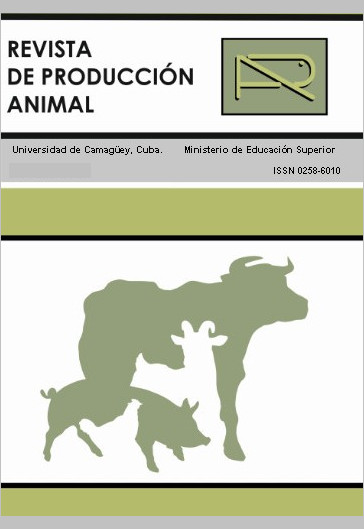Intensidad de pariciones al inicio del período lluvioso y sus efectos en la eficiencia bioeconómica de vaquerías comerciales. III. Indicadores económicos
Resumen
El objetivo del trabajo fue comparar, por sus índices económicos, dos períodos de intensificación de parición en vacas lecheras al inicio del período de máximo crecimiento de la hierba en sistemas de bajos insumos en secano y pasto, con muchas similitudes en sus aspectos físicos y productivos de las vaquerías. Se evaluaron mediante análisis de varianza los gastos, ingresos y costos del kilogramo de leche. Los dos períodos de intensidad de parición fueron: Período I las seis primeras semanas y Período II desde la séptima a la doceava semana del período lluvioso (abrilagosto) cuando ocurrieron el 60 % de los partos del año. En el primer período hubo mayores ingresos y menores costos ($ 0,85/kg de leche) mientras que en el segundo fue de $ 0,96/kg de leche, con diferencias significativas (P < 0,05). Estos resultados confirman las ventajas de las mayores intensidades de parición cuando es mayor el aprovechamiento de la base pratense, que implica reducción de suplementos alimentarios costosos.
Descargas
Citas
COMERÓN, B. (2000). Análisis de sistemas lecheros de la cuenca de abasto, sur Argentina (p. 8). Resúmenes del XIV Reunión ALPA, Montevideo, Uruguay. COWAN, R. (2001). Simulation Systems of Dairy Production Farms on large Scale Operation in Tropical
Australian. Asian-Australian Livestock Conference, October, 11-16, Perth. COWAN, R., KERR, D., MOIR, R. and EVERSON, G. (1995). Milk Production in Australian Tropical Dairy Systems. Conference in Agriculture Diploma. Univ. of Queensland, Brisbane. DURÁN, H. (2000). Cambios tecnológicos en la producción de leche en Uruguay. Evento XIV Congreso de ALPA, Uruguay. FORGEY, K. (2003). How and Why Improve Milk Production with Seasonal Mode. Dairy Huds (pp. 3-7). Indiana. GARCÍA LÓPEZ, R. (2003). Alternativas tropicales de manejo y alimentación para vacas lecheras (pp. 1100). Foro de Ganadería, Tabasco, México. GONZÁLEZ, C. (2003). Influencia del patrón de pariciones anuales en el plano nutricional en la producción de leche de novillas y la eficiencia bioeconómica de cooperativas lecheras. Tesis de maestría en Producción Animal Sostenible, Universidad de Camagüey, Cuba. GUEVARA, R.; GUEVARA, G. y CURBELO, L. (2007). Posibilidad de la producción estacional de leche en Cuba. Conferencia de posgrado, Maestría de Producción Animal Sostenible, Universidad de Camagüey, Cuba. HOLMES, C. (2006). Seminario de trabajo sobre el sistema de producción de leche pastoril en Nueva Zelanda. Visita de trabajo a la Universidad de Buenos Aires. Boletín de industria animal, nov. 11-18, 3-5. LOYOLA, C.; GUEVARA, R.; RAMÍREZ, O.; GUEVARA, G.; CURBELO, L.; SOTO, S. y STEERE R. (2010). Efecto de la intensificación de la parición, al inicio del período lluvioso sobre vaquerías comerciales: I Producción de leche. Rev. Prod. Anim. 22 (2): p. 21-26. LUENING, R. (1996). Manual de Administración de Empresas Lecheras. Univ. de Wisconsin. RATH, M. (2003). Irish Dairy Farm. Conference (pp. 3-5), Univ. of Dublin, College of Agriculture. SENRA, A. (2003). Manejo del pasto y la recuperación lechera. Taller de lechería, Sociedad Cubana de Lechería (SOCUL), Asociación Cubana de Producción Animal (ACPA), 1-2 de abril de 2003, Sancti Spíritus, Cuba.
Los autores de los artículos publicados en RPA retienen los derechos de autor de su trabajo, de marca y patente, y también sobre cualquier proceso o procedimiento descrito en el artículo, así como a compartir, copiar, distribuir, ejecutar y comunicar públicamente el artículo publicado en la RPA o cualquier parte de aquel siempre que indiquen la fuente de publicación (autores del trabajo, revista, volumen, número y fecha), pero están de acuerdo en que la revista publique los trabajos bajo una licencia Creative Commons.
![]() Licencia Attribution-NonCommercial 4.0 International (CC BY-NC 4.0)
Licencia Attribution-NonCommercial 4.0 International (CC BY-NC 4.0)






































